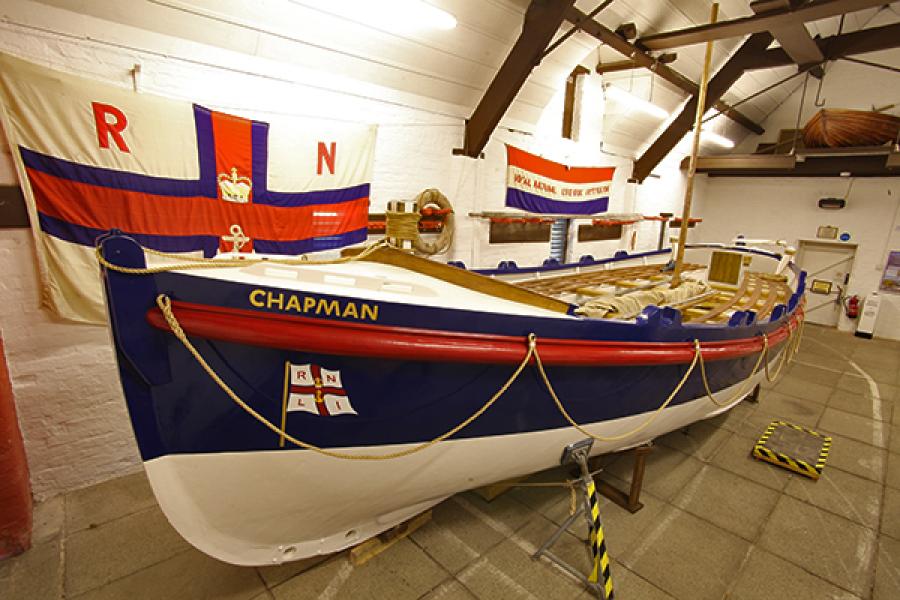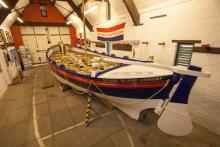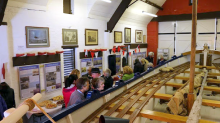Chapman is owned by Click here to show mail address and is currently housed in the old Lytham Lifeboat House.
History of Chapman Lifeboat
ON461 Chapman a Liverpool class pulling and sailing lifeboat was built in 1900–01 at the Thames Ironworks, and Shipbuilding company.
She’s 35 feet long by 10 feet beam, the height to the top of the gun whale is 5 feet and she originally weighed 4.5 tons. She is probably nearer 3.5 tons now.
Built in the era before engines, she was designed to be rowed and sailed by 15 men, 12 oarsmen, a coxswain, second cox’n and bowman. The boat hull is 100% original, Honduran mahogany. Sadly this is no longer available, as all the trees are gone.
Locations
- Chapman was originally stationed in Groomsport, County Down, 1901- 1920.
- When Groomsport closed, Chapman joined the RNLI reserve fleet, 1920-1924. In October 1920 was sent to Cromer, where she was briefly “cox’d” by Henry Blogg, the most famous of all lifeboatmen. Henry was awarded 3 RNLI gold medals, 4 silver medals, the George Medal and British Empire Medal during his 53 years of RNLI service.
- In 1924 Chapman was sent to Hilbre Island (Hoylake) 1924-1939.
- After leaving Hoylake in September 1939, it’s believed that Chapman joined the war effort as a working boat at Point of Air colliery Sept 1939-
- The next we know of her is in the early 1950's renamed Harbinger, engine added used by day trippers in Morecambe Bay.
- Lancaster Pilot boat, Sunderland Point 1956-1989. Renamed Peggy.
- Harold Gardner sold Peggy to Hoylake RNLI Mechanic Alan Tolley on 9th October 1992. Alan sailed her back to Hoylake under her own steam in order to convert her into a tripper. Alan’s intention was to return the lifeboat to her original RNLI livery. He removed the wheelhouse, decking and engine but found himself unable to complete the project. The boat was donated to the Burbo Caravan Park where she became a plaything for children.
- Standing outside in all weathers, the boat begin to deteriorate. The concerned owners of the Park decided to try to find her a secure future, recognising that she was something special. She was next acquired by a Midlander. He transported her to the Douglas Boatyard, Tarleton, on the Ribble estuary. But unfortunately the lifeboat was deserted. Left uncovered, rainwater played havoc with her deteriorating condition. The engine bed rusted badly which penetrated her timbers. Each gunnel burst and she began to rot badly.
- When John Parr and his father Bill visited the Douglas Boatyard in 1998, Peggy was in a sorry state. She was full of leaves and rubbish and also home to a small sycamore tree. However, she was and always will be the last Hilbre Island lifeboat: unique. John bought the boat and brought her back to the Wirral, to the Laird Foundation in Birkenhead. The expectation was that she would be restored by apprentices working at what was, in effect, the shipyard’s training school.
She was fully inspected by John Kearon, Keeper of Historic Vessels at Merseyside Maritime Museum. There was a great deal to be done. Delays occurred, however, and Chapman was laid up for over 3 years.
Restored by Apprentices
Finally, however, the go ahead was given. Chapman was restored by a team of apprentices under the leadership and guidance of Graham Steedman, shipwright and training instructor.
John Parr and his father Bill financed the project. They proudly re-named the lifeboat Chapman at Hoylake’s annual Lifeboat Day in August 2003.
For the next 3 years Chapman formed part of Wirral’s Historic Warship display in Wallasey until this sadly closed in 2006. A period of storage followed.
With the vision of a Lifeboat Museum finally realised in 2011, Chapman finally returned to Hoylake, 72 years after she left at the end of her RNLI service.
The volunteers at Hoylake Lifeboat Museum, under the painstaking leadership of Jon Britton, spent countless hours further restoring the lifeboat over the winter of 2011 and spring of 2012. To bring Chapman even closer to her original appearance, some original features were reinstated.
Then the Hoylake Lifeboat Museum also unfortunately closed.
A New Home in Lytham
The beautifully restored Chapman is now the main exhibit in the new Lifeboat Museum at the Old Lifeboat House, Lytham.
It’s the oldest surviving example of the Liverpool-class lifeboat, of which only around 100 were built. Chapman is of national importance and listed on the National Register of Historic Vessels. It’s a local and national treasure!




